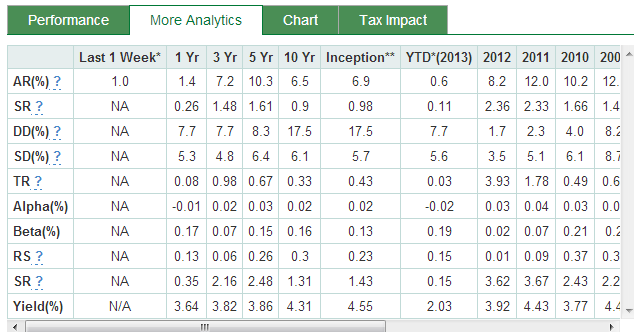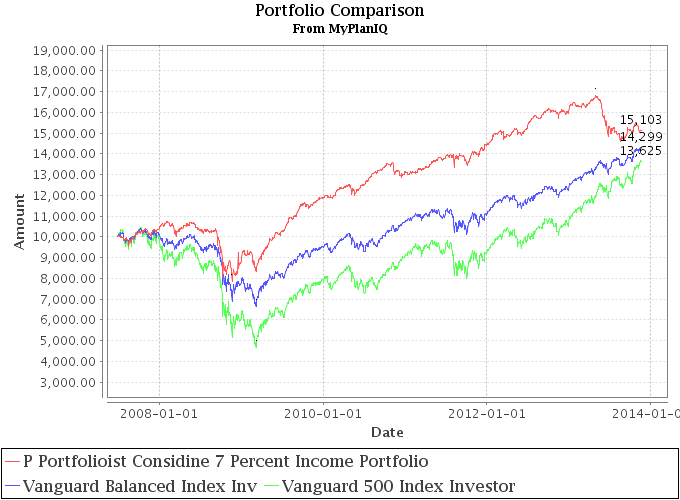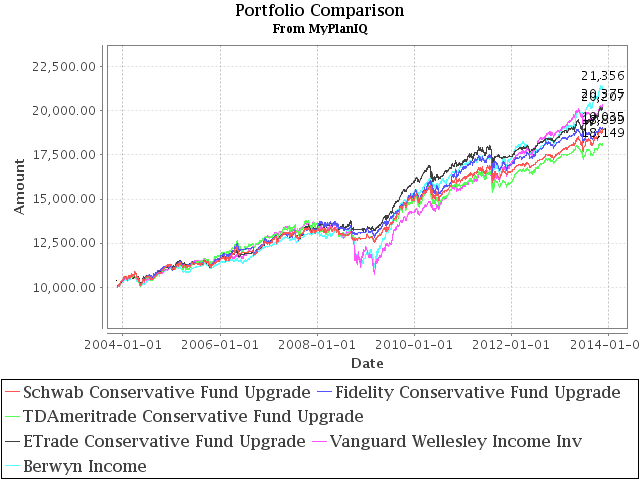Re-balance Cycle Reminder All MyPlanIQ’s newsletters are archived here.
For regular SAA and TAA portfolios, the next re-balance will be on Monday, December 9, 2013. You can also find the re-balance calendar for 2013 on ‘Dashboard‘ page once you log in.
As a reminder to expert users: advanced portfolios are still re-balanced based on their original re-balance schedules and they are not the same as those used in Strategic and Tactical Asset Allocation (SAA and TAA) portfolios of a plan.
Please note that we now list the next re-balance date on every portfolio page.
Review of Various Portfolios
From time to time, we cover some interesting portfolios on MyPlanIQ.com. In this newsletter, we will try to review some of these portfolios.
Permanent and Risk Parity Portfolios
We covered several permanent and risk parity portfolios in February 25, 2013: Risk Parity All Weather & Permanent Portfolio Review. The following shows how these portfolios have performed:
Portfolio Performance Comparison (as of 11/18/2013)
| Ticker/Portfolio Name | YTD Return** |
1Yr AR | 3Yr AR | 5Yr AR | 5Yr Sharpe | 10Yr AR | 10Yr Sharpe |
|---|---|---|---|---|---|---|---|
| Bridgewater All Weather Portfolio Risk Parity | -2.5% | -1.8% | 4.6% | 8.9% | 2.29 | 6.2% | 1.26 |
| Bridgewater All Weather Portfolio | -1.0% | 0.1% | 5.9% | 11.0% | 1.91 | 7.7% | 1.15 |
| Harry Browne Permanent Portfolio | -2.7% | -3.3% | 5.0% | 9.1% | 1.23 | 7.3% | 0.87 |
| Permanent Income Portfolio | 0.6% | 1.4% | 7.2% | 10.3% | 1.61 | 6.5% | 0.9 |
| PRPFX (Permanent Portfolio) | -1.5% | 0.3% | 3.8% | 11.4% | 0.95 | 8.5% | 0.68 |
| VBINX (Vanguard Balanced Index Inv) | 16.0% | 20.2% | 11.4% | 13.8% | 1.08 | 7.0% | 0.5 |
See the detailed year by year comparison >>
With both gold and long term bonds being weak this year, it looks like the permanent portfolios will incur a rare loss this year. For gold, no one knows what is going to happen to gold as it is a more belief and culture made asset. We believe these portfolios will still experience more difficulties in the coming years as the long term bonds will not have much upside left but will have more downside risk. Furthermore, with stocks being elevated, 2 to 3 of the 4 corners in these portfolios are not attractive. However, we caution that regardless of what our own subjective views are, these portfolios are meant to take care of themselves in a long term period.
We would like to make some further comments on Permanent Income Portfolio: the portfolio is a variant of Harry Browne Permanent Portfolio: it invests in inflation protected bonds (TIPS) instead of gold and commodities in the inflation hedge corner. Furthermore, it invests in dividend paying stocks and REITs in stocks and it puts 25% cash into a short term investment grade corporate bonds. By doing so, you are effectively getting a conservative 25% stocks/75% bonds portfolio. This portfolio has a very reasonable average 4.5% annual yield since its start date in 6/2000:
Overall, we express our uneasiness to just buy and hold in such a market condition. However, we still believe that constructing a portfolio in the four corner (or pillar) foundation framework is still a very sound approach. For those who are concerned about possible big loss, you can use tactical portfolios or funds for each corner exposure instead.
For example,
- you can use a fixed income portfolio on Fixed Income Bond Fund Portfolios to get exposure in the bond (deflation) corner
- For stock corner, use a tactical portfolio with risk profile 0. An example portfolio would be MyPlanIQ Diversified Core Allocation ETF Plan Tactical Asset Allocation Most Aggressive listed on MyPlanIQ Diversified Core Allocation ETF Plan or Retirement Income ETFs Tactical Asset Allocation Risk Profile 0 listed on Retirement Income ETFs.
Closed End Fund (CEF) Based Portfolios
We mentioned several closed end based portfolios before. The following are two plans monitored on MyPlanIQ.com:
Portfolio Performance Comparison (as of 11/18/2013)
| Ticker/Portfolio Name | YTD Return** |
1Yr AR | 3Yr AR | 5Yr AR | 5Yr Sharpe | 10Yr AR | 10Yr Sharpe |
|---|---|---|---|---|---|---|---|
| Six Core Asset ETFs Tactical Asset Allocation Moderate | 10.8% | 14.9% | 7.0% | 9.6% | 0.95 | 10.4% | 0.86 |
| Six Core Asset CEFs Tactical Asset Allocation Moderate | 7.0% | 9.6% | 4.9% | 11.6% | 0.85 | 11.3% | 0.74 |
| Five Core Asset CEFs Tactical Asset Allocation Moderate | 12.5% | 15.3% | 7.8% | 13.9% | 1.07 | 12.1% | 0.86 |
| Six Core Asset ETFs Strategic Asset Allocation – Optimal Moderate | 7.5% | 11.9% | 7.0% | 12.4% | 0.88 | 6.4% | 0.4 |
| Six Core Asset CEFs Strategic Asset Allocation – Optimal Moderate | 4.8% | 11.5% | 6.4% | 20.1% | 1.04 | 9.1% | 0.43 |
| Five Core Asset CEFs Strategic Asset Allocation – Optimal Moderate | 7.4% | 14.9% | 7.1% | 20.4% | 1.01 | 8.5% | 0.38 |
As stock markets are doing pretty well at this moment, the CEF based portfolios have achieved better returns, compared with their ETF based counter parts. However, this is achieved with much higher volatility and drawdown. For example, the Six Core ETFs Tactical portfolio had 11.7% maximum drawdown in the past 10 years, compared with 18.7% and 17.2% of Six Core CEFs and Five Core CEFs tactical portfolios respectively. Similar conclusion can be drawn for the strategic portfolios.
You can see more detailed comparison through this link.
One of the major problems to invest in CEFs is that they have relatively low trading volume, even though the six CEFs in Six Core Asset CEFs were picked to have large volumes. These CEFs have average daily trading volume from 73K (EMF) to 800K (CEF). Most of them have about 300K. These are still way too small for accounts of over $100K amount.
We don’t recommend these portfolios for large accounts. These portfolios are only suitable for people who are interested and familiar with closed end funds.
The Income Portfolio With 7% Yield
We first discussed this portfolio in an article The Income Portfolio with 7 Percent Yield Update. The portfolio was constructed by Geoff Considine at Portfolioist.com. At the time, the portfolio drew some interests from several users.
The following shows how this portfolio has performed:
Portfolio Performance Comparison (as of 11/18/2013)
| Ticker/Portfolio Name | YTD Return** |
1Yr AR | 3Yr AR | 5Yr AR | 5Yr Sharpe | 10Yr AR | 10Yr Sharpe |
|---|---|---|---|---|---|---|---|
| P Portfolioist Considine 7 Percent Income Portfolio | -5.8% | -4.8% | 4.8% | 12.3% | 1.24 | ||
| SPY (SPDR S&P 500) | 28.3% | 35.6% | 16.9% | 18.3% | 0.86 | 7.6% | 0.32 |
| DVY (iShares Dow Jones Select Dividend Index) | 27.3% | 34.0% | 17.9% | 15.4% | 0.73 | 6.9% | 0.28 |
| VBINX (Vanguard Balanced Index Inv) | 15.8% | 19.6% | 11.7% | 13.7% | 1.08 | 7.0% | 0.5 |
For more detailed comparison, see this link.
The portfolio sported 7.68% average annual yield in the last 5 years.
The portfolio took a big hit since this May when rising interest rate concern started to surface. We should note that there has been an authoritative research on closed end fund market: in general closed end funds will experience much higher discount in a rising rate environment. Since this portfolio employs several closed end funds, bond funds, utilities stocks and some mortgage REITs, they were all affected in this environment.
The takeaway from this portfolio is that one can construct a portfolio with a good yield. But measured using total return metric, high yield does not necessarily equal to high total return and low risk.
Portfolio Performance Review
Here is the performance of Conservative Allocation Fund Portfolios:
Portfolio Performance Comparison
| Ticker/Portfolio Name | YTD Return** |
1Yr AR | 3Yr AR | 5Yr AR | 5Yr Sharpe | 10Yr AR | 10Yr Sharpe |
|---|---|---|---|---|---|---|---|
| Schwab Conservative Fund Upgrade | 7.3% | 9.3% | 5.8% | 8.2% | 1.52 | 6.6% | 1.01 |
| Fidelity Conservative Fund Upgrade | 4.2% | 6.2% | 5.3% | 7.8% | 1.46 | 6.6% | 1.03 |
| TDAmeritrade Conservative Fund Upgrade | 4.5% | 6.7% | 4.9% | 7.3% | 1.23 | 6.1% | 0.87 |
| ETrade Conservative Fund Upgrade | 9.0% | 10.9% | 6.1% | 8.7% | 1.63 | 7.3% | 1.18 |
| VWINX (Vanguard Wellesley Income Inv) | 8.2% | 10.0% | 9.5% | 12.0% | 1.79 | 7.3% | 0.93 |
| BERIX (Berwyn Income) | 14.7% | 18.1% | 8.9% | 13.1% | 1.93 | 7.9% | 1.17 |
Returns (AR: Annualized Return) include dividend/interest reinvested.
More detailed portfolio info.
Even though these portfolios under performed the two best conservative funds Vanguard Wellesley Income (VWINX) and Berwyn Income (BERIX), they had smaller drawdown (almost half). For people who are most concerned about day to day fluctuation, we believe these portfolios can give you some peace of mind.
On the other hand, because of TDAmeritrade’s excessive minimum holding period policy (minimum 6 months), we still don’t like to use mutual funds in this brokerage. However, if you have a very large account and can negotiate with TDAmeritrade on the mutual fund transaction fee (reduce from $49.99 to something like $19.99 for example), it is still possible to use it (TDAmeritrade actually carries an impressive array of no load no fee mutual funds).
Market Overview
We can use words like ‘relentless’ or ‘reckless’ to describe U.S. stock markets. The continuous ‘melt-up’ is reminiscent of previous bubbles. Nevertheless, we would like to point out the weakness in emerging market stocks and REITs. For more detailed, please refer to 360° Market Overview.
We would like to remind our readers that markets are more precarious now than other times in the last 5 years. It is a good time and imperative to adjust to a risk level you are comfortable with right now. However, recognizing our deficiency to predict the markets, we will stay on course.
We again copy our position statements (from previous newsletters):
Our position has not changed: We still maintain our cautious attitude to the recent stock market strength. Again, we have not seen any meaningful or substantial structural change in the U.S., European and emerging market economies. However, we will let markets sort this out and will try to take advantage over its irrational behavior if it is possible.
We again would like to stress for any new investor and new money, the best way to step into this kind of markets is through dollar cost average (DCA), i.e. invest and/or follow a model portfolio in several phases (such as 2 or 3 months) instead of the whole sum at one shot.
Latest Articles
- Social Security Optimization: Case Study
- The Coach Who Never Punts
- 10 Best Inflation-Protected Bond Mutual Funds
- Is A Financial Apocalypse Coming?
- Longevity Risk Increases With Age
- Wasik Nano Lazy Portfolio, Its Strategic & Tactical Versions
- 8 Best High Yield Muni Mutual Funds For Asset Allocation Portfolios
- Your Plan vs. Reality
- Smart-beta stock ETFs focus on fundamentals
- List of Income-Tested Benefits Programs
- November 11, 2013: Tactical Asset Allocation In Overvalued Stock Markets
Enjoy Newsletter
How can we improve this newsletter? Please take our survey
–Thanks to those who have already contributed — we appreciate it.





 Diversified Asset Allocation Portfolios For Your Plans
Diversified Asset Allocation Portfolios For Your Plans
